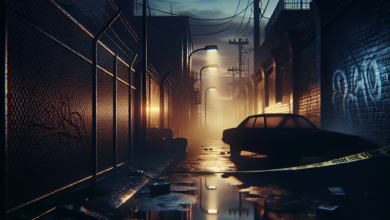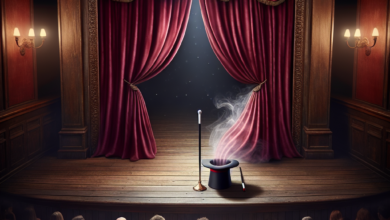Secrets of the Abandoned Asylum
The sun dipped below the horizon, casting elongated shadows across the dilapidated façade of Ravenswood Asylum. Once teeming with the frantic cries of its inhabitants, the crumbling structure now stood silent, its windows shattered like missing teeth, the walls peeling away to reveal the aging bones of a forgotten world. Rumors swirled around the old asylum—tales of a haunted past, of tortured souls and unspeakable experiments conducted behind its barred windows.
Yet, for Carter Evans, this was no ordinary excursion. He had seen the photographs, read the stories, and felt an inexplicable pull toward Ravenswood. Armed with his camera and curiosity, he had embarked on this journey, determined to uncover the secrets that lay in the shadows of the past.
As he approached the main entrance, a heavy iron gate rusted over the years creaked open as if responding to his presence. The air grew thicker with each step; a faint chill crept through the fabric of his jacket. He paused for a moment, capturing the ominous structure in the frame of his camera, feeling the weight of history in the air.
Inside, the atmosphere turned heavy with the scent of mold and decay. Sunbeams fought their way through cracked ceilings, illuminating patches of dust that danced lazily in the air. Each footstep echoed like a heartbeat as Carter ventured further, his heart pounding with a mix of fear and excitement.
He entered a room lined with faded portraits—the once proud faces of the asylum’s founders, their eyes seeming to follow him, judging. Dust motes shimmered in the shafts of light, transforming the dark gloom into an eerie twilight. He focused his camera, capturing these remnants of a bygone era, but in the back of his mind lingered a question that refused to fade: What had happened within these walls?
Moving deeper into the asylum, he found peeling paint that whispered tales of neglect and despair. The wards were barren, but the echoes of madness felt palpable. He clicked away with his camera, but with each shutter sound, another heartbeat quickened within him. This wasn’t just an exploration; it felt like an intrusion into something far more profound.
In the far west wing, a door stood ajar, its rusted hinges barely clinging to the frame. A rush of cold air greeted him as he pushed it open; he felt as if he were stepping into a portal, a threshold between past and present. Inside, the room was devoid of furniture, save for a solitary chair that sat opposite a shattered mirror.
Carter approached the chair and examined it closely. A tingle ran down his spine. There was something about the chair—an odd energy radiated from it. Could it have been the seat of someone who had undergone unspeakable treatment?
Just then, a rustling sound broke the stillness.
Carter spun around, heart racing, aiming his camera toward the sound. Shadows shifted; the remnants of the past seemed to congeal around him. He steadied his breath and stepped cautiously forward, but nothing remained except dust and silence.
Determined to uncover the truth, Carter pressed on, turning his attention to a door at the far end of the hallway, its hinges screaming in protest as he pushed it open. Inside was a long corridor lined with doors, each one labeled with faded, peeling paint—a remnant of a time when the asylum classified its inhabitants: "Severe Depression," "Paranoia," "Delusional Disorder."
A chill swept through him, and he approached the first door labeled "Patient 47." It swung open, revealing a small, darkened cell. He ventured inside, his camera capturing the somber environment, but the air thickened as he stood in the center of the room, which felt heavier than the rest of the asylum.
Suddenly, a flicker caught his eye. In the corner, he noticed something half-buried beneath a layer of dust. It was a diary, its leather cover cracked and aged. He gingerly picked it up, the pages brittle and yellowed. Flipping through them, he discovered the poignant entries of Amelia, a young woman confined within these walls in the late 1940s. Her words revealed a chilling descent into insanity—a mix of despair, isolation, and fear.
“…I can hear them whispering in the dark. They watch me from the corners. I am not sure how much longer I can bear it. They will find a way to silence me…”
The weight of her despair pressed heavily on Carter’s chest. He could almost hear her echoing thoughts resonating within these walls. As he continued reading, he discovered something more disquieting—a series of entries detailing horrific experiments conducted on patients. Amelia had documented the transformations and the faces of those who vanished without explanation.
The door creaked behind him, and Carter’s pulse quickened. He shot a glance back and glimpsed something—a shadow loomed just outside the beam of light streaming in from the corridor. His imagination swirled, conjuring images of the tortured souls Amelia described.
“Get a grip,” he muttered under his breath, shaking off the growing apprehension. He needed to find out more, to uncover the truth of what had transpired in this forsaken asylum. Perhaps there was a hidden room or a basement where the most haunting experiments occurred.
Guided by curiosity, Carter made his way back to the hallway. He was drawn to the farthest door, which stood slightly ajar, almost inviting. He pushed it open cautiously. Inside, the air was stagnant, and he felt a tangible sense of foreboding.
This room was a stark contrast to the others; it was filled with dusty tools and remnants of medical equipment—rusty gurneys and stark, cold structures that once held patients captive for so-called treatment. But what captured his attention most was an old file cabinet against the far wall, covered in cobwebs.
Rushing over, he opened the drawers one by one, revealing records of past patients. He rifled through them, heart pounding in his ears, until he stumbled upon an old manila folder with the words “Patient #43” scrawled on the top. Inside were documents detailing Dr. Harold Wellington’s infamous treatment methods, experiments that were deemed inhumane, designed to alter human behavior.
Carter read the notes trembling as they unveiled injections of untested substances, methods of isolation, and shock therapy. A pencil sketch showed a blueprint—a hidden chamber beneath the asylum, labeled “Experimentation Room.”
At that moment, the ground beneath him shifted ominously.
Instinctively, Carter stumbled back, the cabinet rattling in response. Had he disturbed something—awoken a malevolent spirit? It felt as if the walls themselves shuddered under the weight of those forgotten.
The sensation momentarily subsided, but fear surged through him anew, compelling him to seek the hidden chamber. He found a staircase near the back of the room, its steps swallowed by darkness. Heart racing but fueled by a sense of urgency, Carter descended into the depths below.
The air grew damp and stale, each step crunching on debris. After several minutes, the narrow staircase opened into a vast, underground room. Flickering lights cast a ghostly glow, illuminating stark walls that seemed to whisper secrets. An array of tables lined the space, each marked by bloodstains that eternally tethered them to the horrors of the past.
Frantically, Carter’s camera glided from one gruesome detail to the next—straps on the tables, syringes strewn across the floor, and shackles that echoed with the silent cries of those who suffered here. The atmosphere was laced with a melancholy that hung thick in the air, a weight that pressed against his chest like the burden of a forgotten story.
Suddenly, a low moan echoed through the chamber, freezing Carter in place. He twisted toward the sound, breath hitching in his throat. Shadows moved in the corners, faint whispers merging into a cacophony that seemed almost sentient—alive.
“Help… me…”
The voice was soft but laced with desperation. His heart pounded as he edged closer to the sound, compelled by a mixture of fear and compassion. In the corner of the room, he spotted a figure hunched over, shrouded in darkness.
“Who… Who are you?” Carter called out, though his voice faltered.
The figure turned, its gaze piercing through the gloom, and for an instant, Carter believed he recognized the face—a haunting resemblance to Amelia from the diary, trapped within this veil of darkness.
“I am forgotten,” the figure whispered, her voice ragged. “Help me escape this place!”
Panic surged through him at the thought of engaging with whatever supernatural force held this soul captive. “How… how can I help you?” His heart raced as she extended a trembling hand.
“The chamber…” she beckoned, “it’s the key to my freedom. Destroy it!”
Suddenly, the air crackled with energy, and the room filled with a cacophony of voices—an anguished chorus of the tortured souls who had been subjected to the asylum’s merciless grip. Shadows swirled around him, drawing near as his vision darkened. Carter fought against the tide, adrenaline igniting his instinct to survive.
Clutching Amelia’s diary, he rushed toward the exit, feeling the frigid breath of despair at his back. The moans grew louder, urging him to stay, to join them in their torment. Tears streamed down his face as the darkness clawed at him, desperate to pull him back.
With one final push, he burst into the hallway, sprinting toward the staircase that led back to the upper levels. Determination surged within him as he leaped upward, the whispers trailing behind him. He would not succumb.
Bursting through the door into the lobby, he found the sunlight streaming in, illuminating the dust-filled air. He stumbled toward the entrance, gasping for breath, the echoes of the forgotten souls fading behind him. Consumed by the need to expose the truth, Carter made a decision.
He rushed to the car parked outside and prepared to leave, but something whispered in the back of his mind—he had to do more than just leave. He needed to reveal the asylum’s dark secrets to the world.
Days later, Carter stood in a crowded exhibition hall, photographs neatly displayed on the walls. Each image reflected the fallen glory of Ravenswood, but they also served as a haunting reminder of lost lives.
As the attendees absorbed the story told through his lens, he shared Amelia’s diary—her plight echoing through his words like a bat signal for the voiceless. The submissions reached far and wide; countless individuals rallied to investigate and restore the site, hoping to honor those who had been silenced.
And as the community began to unearth the buried history of the asylum, Carter felt a sense of warmth inside him, the weight of Amelia’s presence still beside him but unlike before—no longer haunting, but triumphant.
The past whispered, but with each revelation, it also began to heal. Ravenswood Asylum transformed from a place of fear and despair into a center for remembrance and healing. Though the shadows of what had occurred could never be entirely erased, the truth had set the restless souls free.
Carter stepped back, clutching his camera, a single tear rolling down his cheek—a silent prayer of gratitude for the souls who would never be forgotten again.
In the aftermath, the abandoned asylum became a place of hope, a living reminder that even the darkest secrets could find their way into the light, transforming despair into understanding. And as Carter roamed the halls once more, now crowded with visitors and stories, he felt an undeniable connection—a bridge between the past and the promise of the future.
In uncovering the secrets of the abandoned asylum, he had woven a tapestry of resilience, reminding every soul that once felt forgotten that their stories mattered. The abandoned asylum no longer stood as a monument of fear; it had become a testament to the enduring spirit of those who endured.
Each whisper of the past slowly faded, replaced by the sound of laughter and renewed hope echoing through the halls—a beautiful symphony of life reclaiming what was rightfully theirs.





